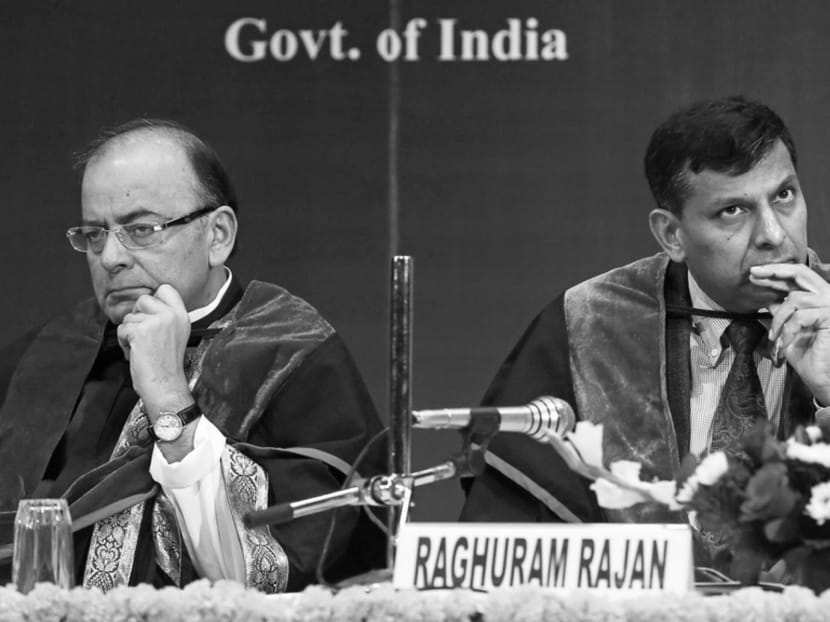India central bank’s independence stays safe
India’s Ministry of Finance and its central bank are on a collision course once more. A new Indian Financial Code, a draft of which was posted on the ministry’s website last week, proposes radical changes to the way the Reserve Bank of India (RBI) decides on monetary policy. At the moment, RBI governor Raghuram Rajan has sole responsibility for deciding what India’s interest rate ought to be.

Finance Minister Arun Jaitley (left) and RBI Governor Raghuram Rajan at a convocation ceremony at a university in Mumbai in January. Photo: Reuters
India’s Ministry of Finance and its central bank are on a collision course once more. A new Indian Financial Code, a draft of which was posted on the ministry’s website last week, proposes radical changes to the way the Reserve Bank of India (RBI) decides on monetary policy. At the moment, RBI governor Raghuram Rajan has sole responsibility for deciding what India’s interest rate ought to be.
The new code proposes to hand over this task to a seven-member monetary policy committee, four of whose members will be chosen by the government. Only three members, including the governor, who will have no power to veto decisions, will represent the central bank.
This is the second major change to the central bank’s operations that Prime Minister Narendra Modi’s government has proposed this year. In February, Finance Minister Arun Jaitley suggested that the task of managing the government’s debt would be shifted from the RBI to an independent debt-management agency. Mr Jaitley withdrew that proposal in May, probably under pressure from a central bank unhappy with a clipping of its wings.
The government seems to be making a tactical retreat from its new proposal, too. Mr Jaitley’s deputy quickly clarified that the draft code had been drawn up only for policymakers to debate. However, it would be unwise for the government to surrender to the RBI and critics, who claim the new proposals will rob India’s central bank of its independence.
The argument that the proposed committee will be beholden to the government is flawed for several reasons. For one, it conflates central-bank autonomy with absolute decision-making powers for its governor. The RBI’s autonomy is institutional and does not depend on the status of its chief.
In any case, the central bank’s governor, its deputy governor for monetary policy and its entire board — a member of which will join the governor and deputy governor as RBI “representatives” on the new committee — are also appointed by the government. In theory, politicians may even now appoint suitably malleable persons to these positions in the hopes of dominating monetary policymaking.
That these figures usually assert their independence is solely because they have institutional protection. As long as the committee’s structure, functioning, responsibility and accountability are set in no uncertain terms — the minutes of all meetings should be public, as well as the details of how each member voted — its members (presumably experts) should have enough incentive not to act as government shills.
Remember, most modern central banks, whether in the United States or the United Kingdom, rely on a group of individuals to decide on interest rates. One person, no matter how brilliant and independent, may make a wrong decision. And in India, recent central bank chiefs have been behind the curve in raising or lowering interest rates.
Fears of encroachment on the RBI’s independence also fail to take into account recent developments in India’s monetary policy. In March, for the first time, the government set an explicit inflation target for the central bank. Before then, the RBI had pursued multiple goals — managing inflation, growth and exchange-rate stability.
Theoretically, though it was free to pursue those goals as it wished; in reality, it had to consult the government. Now, its goal is clear. Once that target is set, the monetary policy committee will have to strive to meet it, regardless of any pressure from politicians.
The RBI governor would still retain enormous influence as a member (and likely chairperson) of the new committee and would be free to use his powers of persuasion to sway others. In any case, other bank functions such as regulating the nation’s banking system and managing the government’s debt will remain with the governor.
With time, modern best practices would dictate changes to those roles too. For now, the government should not allow the central bank to confuse what is essentially a turf battle with a false narrative about the loss of its independence. BLOOMBERG
ABOUT THE AUTHOR:
Dhiraj Nayyar is a journalist in New Delhi and editor of Surviving The Storm: India And The Global Financial Crisis.






